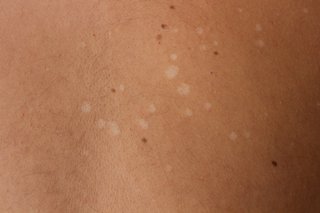Pityriasis versicolor is a common fungal infection. It causes small patches of skin to become scaly and discoloured.
Symptoms of pityriasis versicolor
Patches of skin may be darker or lighter than your normal skin colour. Patches can also be red, brown or pink. They tend to develop gradually and may join up to form larger patches over time.

The areas most often affected by pityriasis versicolor include the:
- back
- chest
- upper arms
- neck
- tummy
Pityriasis versicolor is harmless. It may look unpleasant and the patches are sometimes itchy.
You may still want to see your GP, as it usually only improves with treatment. They can normally diagnose pityriasis versicolor by examining your skin.
Causes of pityriasis versicolor
Pityriasis versicolor is caused by a type of yeast called Malassezia. It normally lives on the skin without causing any problems.
Pityriasis versicolor can develop if this yeast starts to multiply more than usual. It's not clear exactly why this happens in some people and not in others.
Several factors can increase your risk of developing pityriasis versicolor, including:
- living or staying in a warm, moist environment, - this can include Ireland in the summer
- sweating excessively (hyperhidrosis)
- creams, dressings or clothing that do not allow your skin to breathe
- being malnourished
- having a weakened immune system
- being a teenager or in your early 20s
Pityriasis versicolor is not related to poor hygiene. The condition cannot be spread from person to person because most people already have the Malassezia yeast on their skin.
Treatment for pityriasis versicolor
Pityriasis versicolor can be treated with antifungal medicines. These are available as shampoos, creams and tablets.
Antifungal shampoos
Antifungal shampoos are often the first treatment recommended for pityriasis versicolor.
They are available to buy over the counter from pharmacies, or your GP can prescribe them.
Lather the antifungal shampoo on the affected area and leave it for 5 to 10 minutes before rinsing. You may need to repeat this every day for 5 to 7 days. It may be helpful to dilute the shampoo with water before you put it on.
You may have some skin dryness or irritation when using these shampoos.
Antifungal creams
If only small areas of skin are affected, your GP may prescribe an antifungal cream.
These creams usually need to be put on the affected area once or twice a day for several weeks.
Antifungal tablets
If a large area of skin is affected or other treatments have not helped, you may be prescribed antifungal tablets.
These usually need to be taken once a day for 1 to 4 weeks.
Side effects of these tablets are rare. Some people may get a rash, feel sick and have tummy (abdominal) pain while taking them.
After treatment, it can take several weeks or months for your skin to return to its normal colour. In more serious cases, treatment may need to be repeated.
Recurring pityriasis versicolor
It's common for pityriasis versicolor to come back after treatment. This can happen during summer in Ireland, or trips to warm and humid countries.
But you can reduce the risk of it coming back by regularly using antifungal shampoos.
Your GP may prescribe antifungal tablets to take a few times a month to stop it coming back.
They may also refer you to a skin specialist called a dermatologist.
Pityriasis versicolor and vitiligo
Pityriasis versicolor can sometimes be confused with vitiligo, as they both cause the skin to become discoloured in patches.
But there are ways to tell the difference:
| Vitiligo | Pityriasis versicolor |
|---|---|
| Vitiligo often develops on both sides of your body at the same time | Pityriasis versicolor does not affect both sides of the body at the same time |
| Vitiligo skin affected by vitiligo usually has a normal texture | Pityriasis versicolor areas affected by pityriasis versicolor are usually slightly scaly or flaky |
| Vitiligo vitiligo is more common around the mouth, eyes, fingers, wrists, armpits and groin | Pityriasis versicolor pityriasis versicolor tends to develop on the back, chest, upper arms, neck and tummy |
Content supplied by the NHS and adapted for Ireland by the HSE
